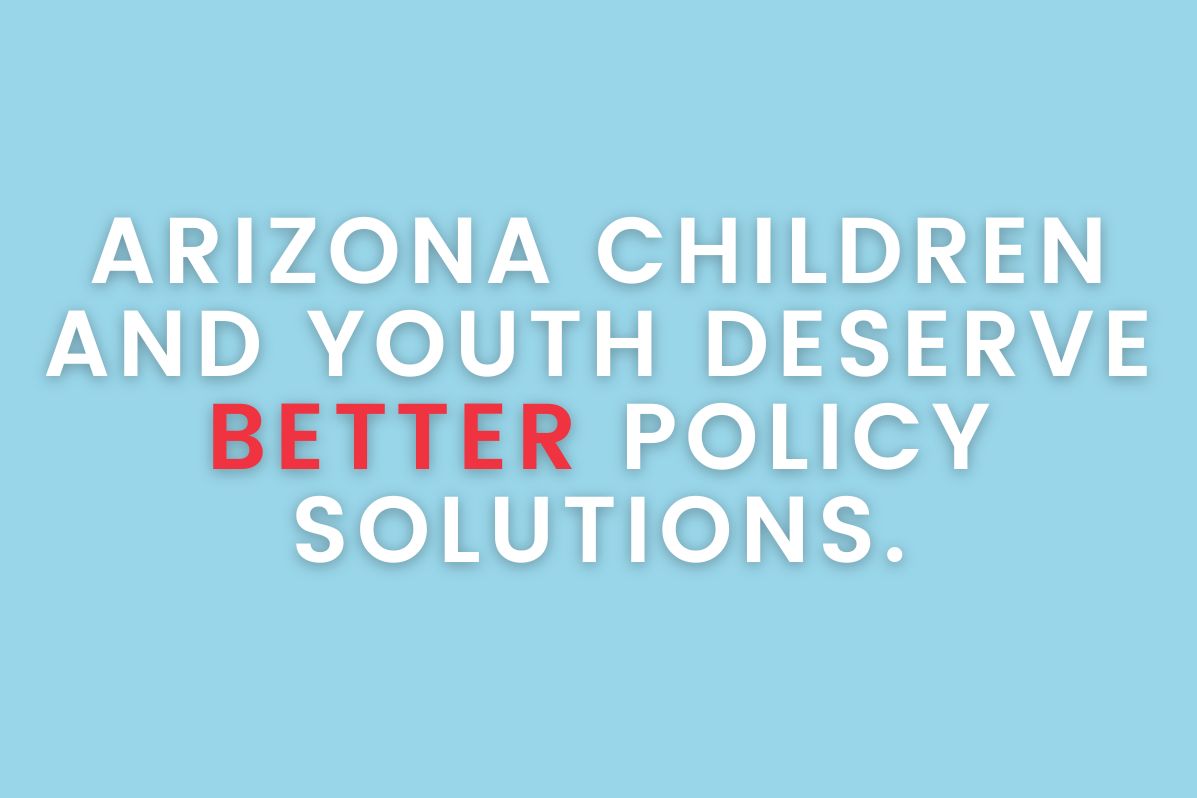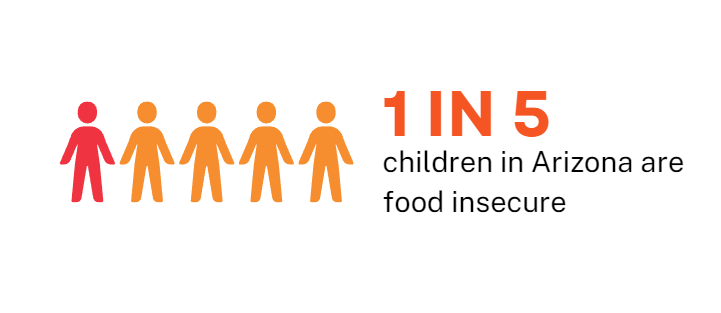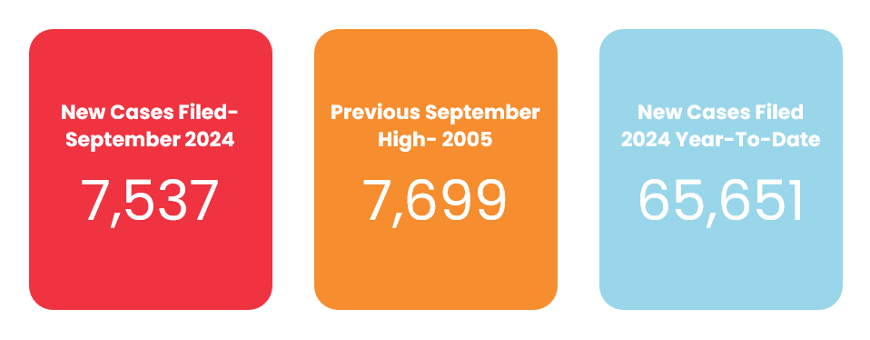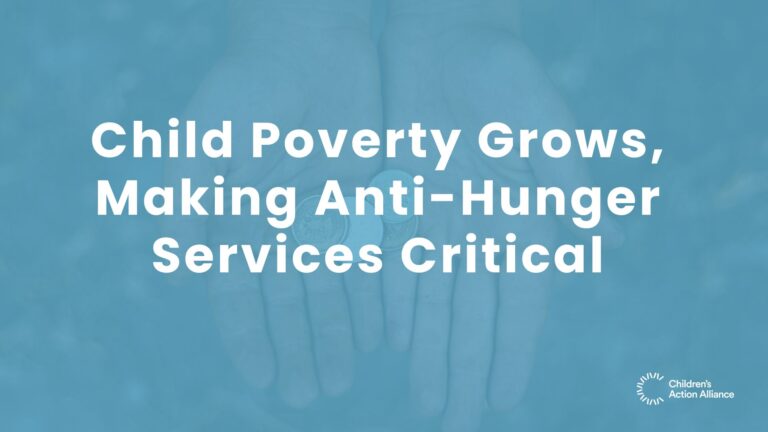
Policy Solutions Can and Should Prevent Hunger and Homelessness Among Children and Youth
Every year, National Hunger and Homelessness Awareness Week is recognized intentionally right before Thanksgiving as an opportunity to bring attention to those who do not have a place to call home or know when their next meal will be.
At Children’s Action Alliance (CAA), bringing awareness to the impact of homelessness and food insecurity on children and youth in Arizona is an important part of advocating for solutions that work.
Food Insecurity in Arizona

‘Food insecurity’ is an official term from the United States Department of Agriculture. Food insecurity is when people do not have enough to eat and do not know where their next meal will come from. Food insecurity affects more than 13 million U.S. children. In Arizona, one in five children are food insecure. Food insecurity is correlated with long-term damage to children’s health and academic success. By kindergarten, food-insecure children are often cognitively, emotionally, and physically behind their food-secure peers. This shows the need for continued awareness for these families who are experiencing difficult times so Arizona can promote growth, development, learning, and overall health, especially for Arizona’s most vulnerable children.
Rising Cost of Food
Consider how the rising price of food impacts families. The national average price of a dozen eggs was $1.53 in March 2020 before pandemic impacts took hold. In August 2024, the average cost of a dozen eggs was $3.82. For one pound of ground chuck beef during this same period, the price rose from $4.11 per pound to $5.64. The rising cost of food significantly impacts children by increasing the risk of food insecurity, particularly for low-income families, as higher prices can force parents to reduce the quantity or quality of food they can provide.
Average Price of Select Goods from October 2004 to October 2024

School Meals Address Child Hunger in Arizona

An avenue to mitigate food insecurity is through school meals. Schools are where children go every day and, for many, a place where they can count on a nutritious meal. School nutrition programs and assistance, including the National School Lunch Program, School Breakfast Program, Community Eligibility Provision, Supplemental Nutrition Assistance Program, and the SUN Bucks Summer Electronic Benefit Transfer Program, have proven to support children’s health and development. Academically, school meal assistance improves test scores, attendance, and behavior.
In Arizona, the number of children receiving free or reduced-price school meals has increased from 52% in 2022 to 58% in 2023. From January 2023 until June 2024, Arizona used $6.75 million federal dollars from the American Rescue Plan Act to waive the reduced-price fee for school meals through the 2023-2024 school year. This investment in children and families provided about 12 million school meals to families. With the expiration of the federal funding, Arizona's fiscal year 2025 budget had a major win in addressing child hunger with an appropriation of $3.8 million in one-time funding to continue investing in school meals for students with low incomes attending public and charter schools. However, advocacy will be needed again in the next legislative session as this was only a one-time appropriation. Continuing to increase access to, strengthen, and invest in school meals will further support and improve a child’s health and well-being.
Housing Obstacle for Arizona Families: Evictions are Rising
Hunger and homelessness are intricately linked, profoundly impacting the health and education outcomes of children and families. 57% of children in low-income households also experience high housing costs in Arizona. Increasing housing costs increase the risk of eviction and homelessness because of the barriers to securing stable housing. The Maricopa County Justice Court recently reported that 7,537 households in Maricopa County alone faced eviction proceedings in their court in September. The last time the number of eviction proceedings was this high in September was more than twenty years ago. Housing instability is associated with stress and trauma consequences to families, and children who have experienced multiple moves or homelessness are more likely to develop various health conditions, including mental health illnesses, respiratory conditions, and infections.
Maricopa County is Seeing the Most Evictions Filed Since 2006

Youth, and Especially Youth Who Have Experienced Foster Care, are at Risk for Homelessness
In addition to rising housing costs, other barriers include limited availability of affordable housing, landlord rejection of housing vouchers, and economic disparities that disproportionately impact certain populations, including youth.
Youth who have experienced foster care are at a high risk of homelessness. In its budget proposal to be decided in the next legislative session, the Arizona Department of Child Safety proposes reducing this risk for youth transitioning to adulthood through an ongoing investment of $434,000 to continue providing stable housing and proper placement to vulnerable youth who are aging out of the foster care system. This investment is important as it aims to increase transitional housing capacity by almost 80%, which reduces the risk of homelessness for young people.
Housing Instability Impacts a Child’s Ability to Thrive
Homelessness, along with food insecurity, is a social determinant of health, according to the World Health Organization - meaning it is an external factor beyond an individual's control that impacts their overall well-being. When children lack a safe place to live or sufficient food to eat, both their physical and mental health are compromised. In 2023, the Arizona Department of Education assessed the impact of homelessness on children's lives, finding that students who are experiencing homelessness experience significantly higher rates of developmental delays, emotional challenges, and academic struggles compared to their housed peers.
Educational Outcomes of Students Who are Homeless vs. Housed in Arizona (SY2022-2023)

During the 2022-2023 school year, assessment data shows a significant difference in educational outcomes between children and youth experiencing homelessness and housed children. For instance, only 15% of children and youth experiencing homelessness met proficiency standards in English, compared to 30% of all students. Math proficiency was even lower, with just 10% of impacted students meeting expectations, contrasted with 22% statewide. Children experiencing homelessness also faced high dropout rates of 13.4%, and 45% were chronically absent.
Solutions to Homelessness Must Address Disparities
These disparities are also more pronounced among communities of color and LGBTQ+ youth, who are overrepresented in populations that experience homelessness. In the 2022-2023 school year, Black students represented 5.6% of all enrollees, but 13.8% of those who have experienced homelessness, and Native American students made up 4.2% of overall enrolled students, but 11% are impacted by homelessness. LGBTQ+ youth are also overrepresented among young people experiencing homelessness and housing instability, as homelessness often stems from family conflict and discrimination, exposing them to greater mental health risks and safety concerns.
Bringing Awareness to Action
Ending child food insecurity and homelessness must be a national and local health and education priority. The long-lasting negative outcomes of child food insecurity and homelessness translate to not just poor health but also to poor academic and economic outcomes.



